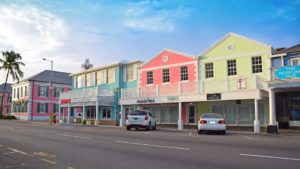
Bay Street
A few years back, a small contingent of civic leaders from Palm Beach County were invited to Nassau, Bahamas to advise the government on how to revitalize their main drag, Bay Street.
The trip was organized by the U.S. Embassy which was manned back then by Ambassador Ned Siegel, a Boca resident who was appointed to his post by President George W. Bush.
I was invited along with former Mayor Tom Lynch, Boca Chamber President Troy McCllellan and Kelly Smallridge, the President and CEO of the Business Development Board of Palm Beach County.
The trip was truly a first class adventure and Ambassador Siegel introduced us to top government ministers and prominent business leaders. We later invited many of those people to Palm Beach County where they toured West Palm Beach, Boca Raton and Delray Beach so we could show them how theory met practice when it comes to revitalizing downtowns.
I was reminded of that trip last week when I walked Bay Street with my wife as part of a cruise to The Bahamas.
Nassau is picturesque and enjoys wonderful weather. There are some great old buildings enhanced by vibrant colors and a scale that is reminiscent of Delray.
In fact, there are a lot of historical ties between Delray and The Bahamas. Some of the earliest settlers in our town were from The Bahamas. I was especially intrigued by the Pompey Museum of Slavery.
C. Spencer Pompey and his wife H. Ruth Pompey are dear old friends and local legends. I’m pretty sure there is a connection between the museum and the Pompey’s of Delray. Sadly, Mr. and Mrs. Pompey have passed so I can’t ask them but I plan to delve into the history to satisfy my curiosity.
When we were invited to share ideas and best practices with The Bahamian government about a decade or so ago, Bay Street was struggling with crime issues, vacancy in certain sections, an underutilized waterfront and stiff competition from the Atlantis resort which was sucking tourists off the cruise ships out of the downtown and into the casino and water parks.
Walking around Bay Street last week I saw the same issues—only now there is another mega resort to worry about: Bahia Mar.
Sure the streets were crowded on a warm Sunday but it didn’t appear that many people were shopping. The retail mix is heavy on t-shirts, perfume, duty free alcohol and jewelry—not surprising given the heavy influx of tourists.
Bay Street could use more food options—and while I didn’t feel unsafe (despite warnings from the cruise line about crime) the level and intensity of solicitors was a turn off. You were just assailed from the moment you get off the boat to the moment you get back on. Yuck….
Years ago we recommended that Nassau turn up the Bahamian charm—for example increase security but outfit police in traditional uniforms and activate the waterfront by incentivizing restaurants and cafes to balance the multitude of t-shirt shops. Granted these aren’t “genius” ideas and I can’t remember the rest but the exercise was fun and we made a lot of friends as a result.
That I didn’t see a whole lot of change on Bay Street is indicative of how hard transformation is to achieve.
When I think of Delray’s transformation I feel the same way. It takes a whole lot of hard work, dedication, investment and some gutsy decisions to make change—and a fair amount of good fortune too. It helps to catch a break or two along the way, but by the same token change doesn’t happen by accident. It happens via intention.
Recently, I ran into some consultants who worked on our downtown master plan way back in 2001.
The efforts our community made over the years were rewarded with awards which are nice….but not as important as the opportunity and value that were created.
Now I get that not everybody was pleased with the results. And they are entitled to their opinions and we are compelled to respect those views.
Yet, I can’t help but think that sometimes we go overboard with our angst. The consultant mentioned to me that “Delray is so hard on itself” and that statement struck me. It rang true.
Just take a cruise through social media to see for yourself—ugh… all the negativity.
Criticism that isn’t constructive isn’t valuable at all. It doesn’t feel like affection it feels like anger.
Accountability is necessary and important, but it’s best when it’s rooted in love and empathy.
As we head into the holiday season, I hope we see more love and less anger. More constructive guidance and empathy and less vitriol and blame.
Root your community in those values, observe the guardrails and be patient. The magic will happen.








